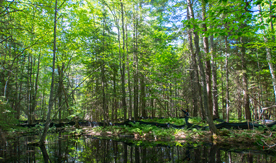
Research Shows 15-year History of Wetland Management
A new article in the Proceedings of the National Academy of Sciences (PNAS) documents nearly 15 years of vernal pools research and management by the University of Maine’s Aram Calhoun who is leading an interdisciplinary team at the Sustainability Solutions Initiative (SSI), a program of the Sen. George J. Mitchell Center.
In the article, published this week online at pnas.org, Calhoun and three co-authors analyze a timeline of action and scholarship that spans from 1999 to the present. In that time, the professor of wetland ecology and director of UMaine’s Ecology and Environmental Sciences program has collaborated closely with academic colleagues, government at all levels, nongovernmental organizations, landowners, developers and concerned citizens in an effort to create an environment in which these small, but significant, wetlands can flourish.
The article’s co-authors and SSI collaborators are Jessica Jansujwicz, a SSI postdoctoral fellow, Kathleen Bell, associate professor of economics, and Malcolm Hunter Jr., Libra professor of conservation biology and professor of wildlife ecology. The authors acknowledge and thank the many additional faculty and students who contributed to the research and outreach reported in the article.
“It is our hope that the work presented in this paper will inspire other researchers, practitioners and citizens dedicated to planned development and conservation of natural resources to forge new working relationships,” Calhoun said. “Our work shows that time, patience, open-mindedness and the willingness to assume a bit of risk are key to successful collaborations on difficult conservation issues. We have found that the time invested is well worth the effort. The exchange and synthesis of diverse ideas lead to outcomes that are more widely embraced and enduring.”
The effort to protect vernal pools has required a high level of perseverance and creativity, Calhoun says. Tensions among private landowners, ecologists and government entities over resource location, function and management strategies have stymied progress for years. Thus, vernal pools require a different kind of attention than many other types of natural resources, Calhoun and colleagues say. The pools, located mainly on private land, are a key-breeding habitat for several amphibians and serve as an important wetland resource for wildlife. They can be hard to detect. The tiny pools fill with water each spring and often dry up by summer’s end. Researchers stress that multidisciplinary, stakeholder-engaged efforts open the door to innovative strategies that can conserve pools while encouraging development. The diverse perspectives provide a basis for compromise, they say. It is the very nature of these pools, their size and locations that introduce this opportunity for practice of a new sustainable science model, researchers say.
In her 15-year involvement with vernal pools in Maine, Calhoun has played a major role in shepherding in a new era. In 1999, Calhoun and others in a diverse working group pushed for a new state law that better protects vernal pools. It passed. They coupled important scientific discoveries with successful public education programs. More recently, Calhoun, SSI researchers and key stakeholders collaborated to develop a streamlined, locally-tailored approach to regulation, one that could make compliance less encumbering for towns and land developers while better protecting vulnerable amphibian populations. Bell says the successful collaboration laid out in the article is a model of sustainability with real world impact.
“This paper is exciting because it advances interdisciplinary, engaged research as a viable tool to address complex conservation challenges,” Bell said. “It is a story about sustainability science — a journey to link knowledge with action along the road to conservation solutions.”
Hunter added that the team’s work has major implications for conservation far beyond Maine and the region. “One of the most important aspects of this work is that it nicely illustrates a larger principle: that focusing conservation on small bits of the landscape can have disproportionately large effects on ecological integrity at a much larger scale,” he said. Vernal pool conservation was the focus of Jansujwicz’s dissertation. She emphasizes SSI’s mission to include stakeholders as partners in research and solutions: ”Our research demonstrates the value of engaging stakeholders throughout the research process. With their participation, we can design and conduct research that is more flexible, creative, and responsive to diverse concerns.”
Next up for Calhoun and SSI vernal pool researchers: continued study funded by a $1.49 million grant from the National Science Foundation’s (NSF) Dynamics of Coupled Natural and Human Systems Competition (CNH) Program. The four-year project, Of Pools and People, began in 2013 and supports research focused on more effective strategies when it comes to vernal pools and small, natural landscape features that contribute disproportionately to larger ecosystem functions.
Supported by National Science Foundation award EPS-0904155 to Maine EPSCoR at the University of Maine.
Contact: Tamara Field, 207.420.7755
